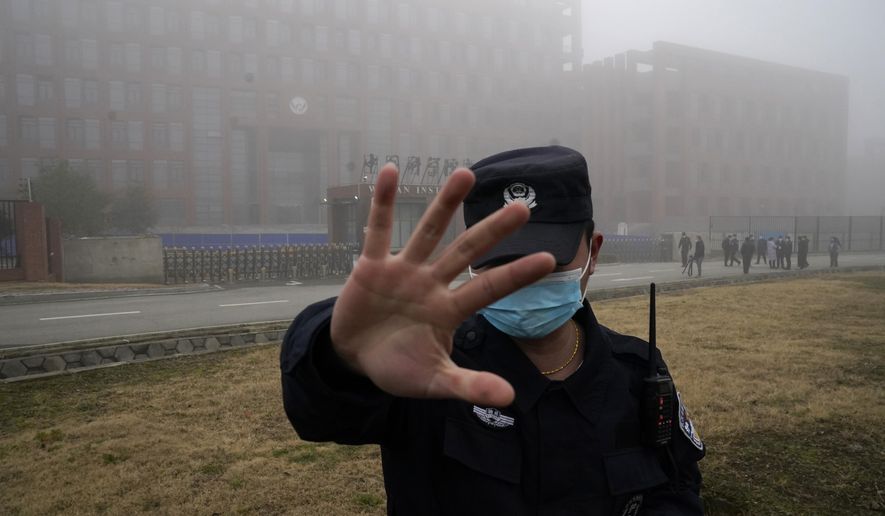Pentagon officials offered a qualified denial Tuesday when questioned on whether any of the nearly $40 million in defense money given to a non-government organization may have been used for research at the Chinese military-linked Wuhan Institute of Virology, a suspected potential origin point for the COVID-19 pandemic.
Rys Williams, acting director of the Defense Threat Reduction Agency, and Brandi Vann, acting assistant defense secretary for nuclear, chemical and biological defense programs, told a House Armed Services subcommittee hearing that all the funds they reviewed from DTRA and other government sources did not go to the Chinese institute following reviews of grants to EcoHealth Alliance, a New York-based NGO that worked closely with the WIV.
“We have done a thorough look at all of our programmatic activities to ensure that at least the Defense Threat Reduction Agency’s funding to this NGO was not provided, to the best of our knowledge, into the Wuhan Institute of Virology,” Mr. Williams told the House panel that focuses on special operations.
Mr. Williams said DTRA reviews all activities related to NGOs “to make sure that the risk for government funding is minimalized and in keeping with the traditions and the boundaries of the federal acquisition process but equally in policy as well.”
Ms. Vann, the acting assistant defense secretary, added that other defense agencies involved in nuclear, chemical and biological (NCB) programs reviewed funding of EcoHealth Alliance research and found no links to the Chinese lab.
“We also across the NCB did a thorough review to identify any potential access or investment into the Wuhan laboratory, and we have not identified any,” she said in response to questioning from Mississippi Rep. Trent Kelly, the ranking Republican member of the subcommittee. “It is something that we continue to watch to ensure that our investments are not going to places where they should not be,” she noted.
Mr. Kelly asked the two defense officials “what kind of risk assessment or risk analysis we’ve conducted and how the Wuhan Institute of Virology became the partner of choice for U.S. government agencies, given its ties to the PLA,” he said, using the acronym for People’s Liberation Army, the Chinese military.
A State Department fact sheet made public in January for the first time disclosed that the WIV was engaged in covert biological weapons research with the PLA. Chinese officials at the WIV have denied the institute works with the PLA.
According to the fact sheet, the WIV is engaged in “secret military activity.”
“Secrecy and non-disclosure are standard practice for Beijing,” the fact sheet said. “For many years the United States has publicly raised concerns about China’s past biological weapons work, which Beijing has neither documented nor demonstrably eliminated, despite its clear obligations under the Biological Weapons Convention.”
The collaboration at the institute includes both publication and secret military projects including classified research and laboratory animal experiments. The work between WIV and PLA has been underway since 2017.
Director of National Intelligence Avril Haines told Congress last month that U.S. intelligence agencies believe the pandemic began either through a leak from a Chinese laboratory or from an animal host. Many scientists and mainstream news outlets for months dismissed all suggestions the virus could have come from a lab as a conspiracy theory.
A list of grants and contracts for EcoHealth Alliance posted on the website of Independent Science News shows DTRA and the Pentagon provided the group with $38.9 million since 2014. DTRA’s funding included $6.49 million between 2017 and 2020 for what the agency called “understanding the risk of bat-borne zoonotic disease emergence in Western Asia.”
According to DTRA, the grant was used for research aimed at “combating or countering weapons of mass destruction” and was to be carried out between 2017 and 2022. It is not clear if the work is ongoing.
The National Institute of Allergy and Infectious Diseases (NIAID) provided EcoHealth Alliance with $3.7 million in funding from 2014 to 2019, and the National Institutes of Health gave the group $2.5 million between 2009 and 2012. The NIAID funds went to a program called “understanding the risk of bat coronavirus emergence.”
A spokesman for EcoHealth Alliance did not return an email and phone call seeking comment.
EcoHealth Alliance President Peter Daszak has worked closely with WIV virologist Shi Zhengli, known as the “Bat Woman of Wuhan” for her work on bat viruses and has been a vocal critic of the Wuhan lab transmission theory. He was also part of the World Health Organization team that investigated the virus origin earlier this year that called the lab theory “extremely unlikely” and not worth pursuing. Critics say the WHO report was influenced by the Chinese government that sought to play down the lab leak theory.
China, according to the Trump and Biden administrations, has engaged in disinformation in a bid to deflect criticism from its handling of the outbreak’s earliest days. The Chinese government refused to provide virus samples to international virus hunters and initially hid the infectiousness of the virus from the world.
More than 3 million people have died since the pandemic broke out in Wuhan in December 2019.
• Bill Gertz can be reached at bgertz@washingtontimes.com.




Please read our comment policy before commenting.